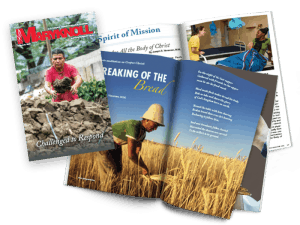A Salesian priest sees the plight of Jesus, Mary and Joseph reflected in South Sudanese refugees in Uganda today
Christmas has taken on a deeper meaning for me this year since I began serving as chaplain for refugees in the Archdiocese of Gulu in northern Uganda. I minister to more than 36,000 South Sudanese who have fled violent civil war in their homeland and are now living in Palabek Refugee Settlement in the Lamwo district, close to the border of South Sudan.
I often remind these people that Jesus was a refugee, from the earliest years of his life. He lived in a strange land deprived of basic necessities, just as they do today. Surely his parents, Mary and Joseph, made great sacrifices to keep their son alive.
Just about every refugee wants to return to his or her homeland and start a new life. In the same way Mary and Joseph could only take their little son home after they spent years of exile in Egypt and the tyrant who threatened their safety at home died. Later Jesus had to live in an environment of oppression under the Roman colonial regime. This lasted until his death on the cross. The celebration of Christmas should not let us forget these harsh realities that Jesus and his parents endured.
Statistics tell us that there are about 1.2 million refugees here in Uganda. About 86 percent of them are women and young children. Uganda has become their temporary home. Here they struggle to live with meager supplies of basic things, including food. Even education and medical care have become luxuries for them. It is consoling for them to know that Jesus became a refugee within days of his incarnation. Hardship and hostility were part of the price he paid when he became human like us.

A child sits on a plastic mat at the Palabek Refugee Settlement in northern Uganda, where more than 36,000 refugees from South Sudan have fled. (Photo S. Sprague / Uganda)
Children are often the ones who suffer most as refugees. They are deprived of their childhood, their freedom, their education and their right to security. I asked a 10-year-old boy, “What do you miss most in the refugee camp?” His immediate answer was, “I want to go to school.” Keeping little children doing nothing is perhaps the biggest punishment for them.
It is important to remember that even before he was born, Jesus was deprived of safety and privacy. The Gospel of Luke (2:1–8) tells us that there was no place for his pregnant mother Mary to give birth, and she and Joseph were forced to take shelter in a cowshed. In Bethlehem, they were passersby, they were strangers, and they were the most needy people. Then from this miserable place, they had to run to Egypt within a few days of the child’s birth.
What did Mary and Joseph carry to Egypt? Perhaps nothing much. One day I asked a refugee, “What did you carry with you when you began to run for your life in South Sudan?” He replied, “I grabbed my 3-year-old child, and my wife took a few pieces of clothing, and we ran.”
The answer from another man was more amazing. “As I was looking for my child,” he said, “I could not find him, but I found my neighbor’s child and I came with her.” We can gather from the Gospel of Matthew (2:19–23) that the only concern of Mary and Joseph was the safety of their newborn child—Jesus.

Forced to do nothing is the biggest punishment for refugee kids. (S. Sprague/Uganda)
One night in the refugee settlement, I went to sleep with a heavy heart. I had just witnessed the arrival of a new group of refugees. They were given a tarpaulin, five poles of trees and a few meters of rope to make a shelter, plus a few household items. As they were being given a small plot of land to pitch their tents, I went to give them some clothes. It began to rain. I ran to take shelter in my little hut. But I was sure those 30 people, mostly women and children, spent their night in the rain. Can we picture Mary and Joseph looking for shelter to protect their child Jesus?
Besides refugees and migrants, there are so many other suffering sections of humanity everywhere in the world. There are those who have been abducted, trafficked, enslaved in war and conflict and so many others pushed to the peripheries of society for economic and political reasons. Many are victims of crime. They all remind us of the sufferings Jesus went through from his birth and throughout his life.
Luke summarizes the attitude all Christians should have in one beautiful sentence: “Mary treasured all these things in her heart” (Luke 2:19, 51). Christmas becomes meaningful when we look at it with faith and trust in God and God’s ways.
May the Advent season and the celebration of Christmas open our eyes and hearts to the suffering people of today’s society, who are often within our own reach. Let Christmas help us to be more compassionate.
—
Featured Image: Children must take on adult roles as refugees in Palabek settlement, such as this young girl who looks after her infant sibling tied to her back while her mother attends to other chores. (S. Sprague/Uganda)
